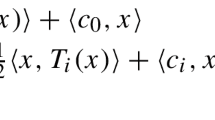Abstract
For convex parametric optimization problems it is shown that the optimal solution is directionally differentiable provided that a strong second-order sufficient optimality condition and Slater's condition are satisfied for the unperturbed problem. This directional derivative is equal to the optimal solution of a certain quadratic programming problem. For the construction of this quadratic problem, a preliminary choice of a “suitable” KKT-multiplier is necessary, which under additional assumptions may be taken as a vertex of the set of KKT-multipliers of the unperturbed problem. In the last part of this paper, the contingent derivative of the optimal solution is investigated.
Similar content being viewed by others
References
J.-P. Aubin and I. Ekeland,Applied Nonlinear Analysis (Wiley, New York, 1984).
B. Bank, J. Guddat, D. Klatte, B. Kummer and K. Tammer,Non-linear Parametric Optimization (Akademie-Verlag, Berlin, 1982).
J.F. Bonnans, “A semistrong sufficiency condition for optimality in non-convex programming and its connection to the perturbation problem,”Journal on Optimization Theory and Applications 60 (1989) 7–18.
L. Collatz and W. Wetterling,Optimierungsaufgaben (Springer, Berlin, 1966).
B. Cornet and J.-Ph. Vial, “Lipschitzian solutions of perturbed non-linear programming problems,”SIAM Journal on Control Optimization 24 (1986) 1123–1137.
S. Dempe, “On the directional derivative of the optimal solution mapping without linear independence constraint qualification,”Optimization 20 (1989) 401–414. [Corrigendum:ibid. 22 (1991) 417.]
V.F. Dem'yanov, C. Lemarechal and J. Zowe, “Approximation to a set—valued mapping I. A proposal,”Applied Mathematics on Optimization 14 (1986) 203–214.
V.F. Dem'yanov and A.M. Rubinov,Quasidifferential Calculus (Optimization Software, New York, 1986).
M.E. Dyer and L.G. Proll, “An algorithm for determining all extreme points of a convex polytope,”Mathematical Programming 12 (1977) 81–96.
A.V. Fiacco,Introduction to Sensitivity and Stability Analysis in Non-linear Programming (Academic Press, New York, 1983).
J. Gauvin, “A necessary and sufficient regularity condition to have bounded multipliers in nonconvex programming,”Mathematical Programming 12 (1977) 136–139.
J. Gauvin and R. Janin, “Directional behavior of optimal solutions in nonlinear mathematical programming,”Mathematics of Operations Research 13 (1988) 629–649.
H. Gfrerer, J. Guddat and Hj. Wacker, “A globally convergent algorithm based on imbedding and parametric optimization,”Computing 30 (1983) 225–252.
R. Janin, “Directional derivative of the marginal function in nonlinear programming,”Mathematical Programming Study 21 (1984) 110–126.
K. Jittorntrum, “Solution point differentiability without strict complementarity in nonlinear programming,”Mathematical Programming Study 21 (1984) 127–138.
H.Th. Jongen, D. Klatte and K. Tammer, “Implicit functions and sensitivity of stationary points,”Mathematical Programming 41 (1990/91) 123–138.
A.J. King and R.T. Rockafellar, “Sensitivity analysis for nonsmooth generalized equations,”Mathematical Programming 55 (1992) 193–212
M. Kojima, “Strongly stable stationary solutions in nonlinear programs”, in: S.M. Robinson, ed.,Analysis and Computation of Fixed Points (Academic Press, New York, 1980) pp. 93–138.
P. Malanowski, “Differentiability with respect to parameters of solutions to convex programming problems,”Mathematical Programming 33 (1985) 352–361.
O.L. Mangasarian and S. Fromowitz, “The Fritz John necessary optimality conditions in the presence of equality and inequality constraints,”Journal on Mathematical Analysis and Applications 17 (1967) 37–47.
S.M. Robinson, “Strongly regular generalized equations,”Mathematics of Operations Research 5 (1980) 43–62.
S.M. Robinson, “Generalized equations and their solutions, part II: Applications to nonlinear programming,”Mathematical Programming Study 19 (1982) 200–221.
A. Shapiro, “Second order sensitivity analysis and asymptotic theory of parametrized nonlinear programs,”Mathematical Programming 33 (1985) 280–299.
A. Shapiro, “Sensitivity analysis of nonlinear programs and differentiability properties of metric projections,”SIAM Journal on Control and Optimization 26 (1988) 628–645.
A. Shapiro, Private communication.
Author information
Authors and Affiliations
Rights and permissions
About this article
Cite this article
Dempe, S. Directional differentiability of optimal solutions under Slater's condition. Mathematical Programming 59, 49–69 (1993). https://doi.org/10.1007/BF01581237
Received:
Revised:
Issue Date:
DOI: https://doi.org/10.1007/BF01581237



